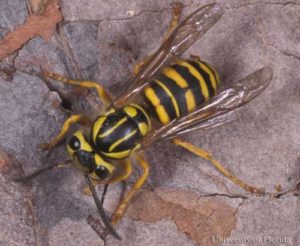I’ll often get a call or office visit about honeybees. They are in a wall, tree, outbuilding or somewhere that is causing (or will cause) problems. And about half the time, they are not honeybees. They are a wasp or another kind of bee.

Lately, I’ve seen a number of yellowjackets as well as the much lesser known cuckoo bees. Their size along with yellow and black markings has confused a number of folks into thinking they are honeybees.
If you want to know if you have yellowjackets or cuckoo bees rather than honeybees, study the markings on the back of the thorax. The thorax is the middle portion of the body of an insect, i.e. head-thorax-abdomen.
I look for the two yellow lines down the back of the abdomen. If the two yellow lines are short, (study the photos) there’s a good chance you’ve got a cuckoo bee. But if the stripes extend all the way down the thorax, you have yellowjackets. The yellow stripes along its abdomen simply look too much like so many other bees and wasps that I wouldn’t want to try and go by those markings alone.
Yellowjackets do perform a valuable service in destroying many insects that attack cultivated and ornamental plants. However, nests near homes may prove a source of irritation.
If the nests are large or difficult to approach, for example within the walls of a house, the safest procedure would be to hire a pest control operator to eliminate the colony. Any attempt to remove or destroy nests by the layman should be done at night when nest activity is at a minimum.
It is important to note that even though nests are relatively inactive at night, any disturbance will result in instant activity by the colony. It is necessary to work cautiously but quickly. Protective clothing is advisable. These wasps are adept at stinging and are especially aroused if danger threatens the nest. Unlike the honeybee, which dies upon inflicting a single sting, these wasps may sting as often as they find a target. In fact, when a yellowjacket is injured it often releases an “alarm pheromone” which quickly results in an aggressive, defensive behavior from other members of the colony.

Yellow Cuckoo bees lay eggs in in the nests of others. Their name is thusly copied from the Cuckoo bird who lays its eggs in the nests of other birds.
Cuckoo bees are one of many native bees that just don’t get the recognition of the honeybees. There are somewhere between 3,000 to 4,000 species of twig-nesting and ground-nesting solitary bees in North America. Many are very efficient pollinators and don’t have a bad temperament, with little interest in stinging.
Our native bees are not social insects like the European honeybee. They feed alone. Instead of living in a large colony, they make very small nests in holes. These holes can be in trees, shrubs or in the ground. These ground-dwelling bees are referred to as miner bees.
Like the honey bee, they are pollinators and vital to agricultural production. Pollination can be simply described as the transfer of pollen of one flower to the another. This transfer of genetic material results in more fruits and/or nuts produced, more seed produced, and insures genetic diversity.
Yellowjackets and most bees are also attracted to sugar sources, such as berries and flower nectars. However, this becomes a problem when the sugar source is a food or drink being consumed by a human. Sweet items like soft drinks, ripened fruits, and watermelons attract bees and wasps. Keep these items covered outdoors.
Both are native and can be considered beneficial. One is ornery and mean while the other slips into hives to have them raise their young. And both are found in our back yard and neither are a honeybee.



